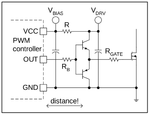R
red_alert
Guest
I'm in the process of redesigning (upgrading) my sine wave inverter and I don't find a suitable (integrated) MOSFET high side/low side driver.
I'm going to use 6 x IRFP4668 in parallel mode for every high side / low side H-bridge switch.
So far I bought some IRS21864 (4 Amp MOSFET driver) but I don't know if that's enough current to drive those MOSFETs.
The switching frequency will be low enough (10 khz) and the nominal switching current is 100 A (from a 48V battery string) for a total of 5 kW rated power.
The IRFP4668 has a total gate charge of 160 nC (max 240) so for six of them I'll have over 1000 nC gate charge.
Does anyone know of any suitable driver for this situation? The price is not a problem (as is for personal use) but I prefer a integrated one (having multiple protections and controlled delay times than a discrete totem pole). Or maybe I should go with a hybrid one?
I'm going to use 6 x IRFP4668 in parallel mode for every high side / low side H-bridge switch.
So far I bought some IRS21864 (4 Amp MOSFET driver) but I don't know if that's enough current to drive those MOSFETs.
The switching frequency will be low enough (10 khz) and the nominal switching current is 100 A (from a 48V battery string) for a total of 5 kW rated power.
The IRFP4668 has a total gate charge of 160 nC (max 240) so for six of them I'll have over 1000 nC gate charge.
Does anyone know of any suitable driver for this situation? The price is not a problem (as is for personal use) but I prefer a integrated one (having multiple protections and controlled delay times than a discrete totem pole). Or maybe I should go with a hybrid one?

